4-253-038-31(1)
Portable Solid
Memory Player
Operating Instructions
UZ-PS128
©2004 Sony Corporation
�
WARNING
To prevent fire or shock
hazard, do not expose the unit
to rain or moisture.
To prevent fire, do not cover the ventilation
of the apparatus with news papers, table
cloths, curtains, etc. And don’t place lighted
candles on the apparatus.
Certain countries may regulate disposal of
the battery used to power this product. Please
consult with your local authority.
For the customers in the
United States
Owner’s Record
The model number is located on the inner rim of
the left ear side of the headphones, and the serial
number is located on the inner rim of the right ear
side of the headphones. Record the serial number in
the space provided below.
Refer to them whenever you call your Aiwa dealer
regarding this product.
Model No. UZ-PS128
Serial No.
NOTE
This equipment has been tested and found to
comply with the limits for a Class B digital device,
pursuant to Part 15 of the FCC Rules. These limits
are designed to provide reasonable protection
against harmful interference in a residential
installation. This equipment generates, uses, and
can radiate radio frequency energy and, if not
installed and used in accordance with the
instructions, may cause harmful interference to
radio communications.
However, there is no guarantee that interference
will not occur in a particular installation. If this
equipment does cause harmful interference to radio
or television reception, which can be determined by
turning the equipment off and on, the user is
encouraged to try to correct the interference using
one or more of the following measures:
2
– Reorient or relocate the receiving antenna.
– Increase the separation between the equipment
and receiver.
– Connect the equipment into an outlet on a circuit
different from that to which the receiver is
connected.
– Consult the dealer or an experienced radio/TV
technician for help.
CAUTION
You are cautioned that any changes or
modifications not expressly approved in this
manual could void your authority to operate this
equipment.
The shielded interface cable recommended in this
manual must be used with this equipment in order
to comply with the limits for a digital device
pursuant to Subpart B of Part 15 of FCC Rules.
If you have any questions about this product,
you may call;
Aiwa Customer Information Service Center
1-800-289-2492 or
http://www.us.aiwa.com/.
Declaration of Conformity
AIWA
Trade Name:
UZ-PS128
Model:
Sony Electronics Inc.
Responsible Party:
680 Kinderkamack Road,
Address:
Oradell, NJ 07649 U.S.A.
201-930-6973
Telephone Number:
This device complies with Part 15 of the FCC Rules.
Operation is subject to the following two conditions:
(1) This device may not cause harmful interference,
and (2) this device must accept any interference
received, including interference that may cause
undesired operation.
Before using this player, install
the application software on
your computer using the
supplied CD-ROM, and send
some music data to the player.
�
Table of Contents
Overview
What you can do with your player ............. 4
Main features .............................................. 5
Getting started
Step 1: Check the package contents ........... 6
Step 2: Insert a battery ................................ 7
Locating controls ........................................ 8
Basic operations
Listening to music stored in your player .... 9
1. Put the player on your ears. .................... 9
2. Start playback. ...................................... 10
Recording from another audio device ...... 12
Erasing tracks one by one ......................... 13
B Advanced operations
Changing the sound quality (M.D.S.E) .... 14
Playing a track repeatedly
(Repeat Play) ........................................ 14
Using the player as stereo headphones ..... 15
B Additional information
Precautions ............................................... 16
Cleaning .................................................... 16
Troubleshooting ........................................ 17
Specifications ........................................... 18
Index ......................................................... 19
3
�
Overview
What you can do with your player
Your UZ-PS128 is a portable player with built-in solid memory. You can play back MP3 files
transferred to the player from your personal computer using the supplied software and the
dedicated USB cable.
You can also record and listen to the sound from another audio device connected to the player
with the supplied analog connection cord.
Once you have stored your favorite songs in the player, take it with you and enjoy music
wherever you go!
2 Enjoy music
anywhere with
your player!
1 Record music
to your player.
There are two ways to store
audio data into your player’s
built-in memory:
• Transfer audio data (MP3
files) from your computer,
using the supplied software
“Music Transfer Solid Memory
Edition.”
See the separate manual for the Music
Transfer software for details.
• Record from another audio
device.
See page 12 for details.
4
�
Main features
• Headphone-style solid memory player
- Highly portable with the player built into the headphones
- Skip-proof using flash memory
• Approximately 11 hours of continuous playback with a single LR03 (size AAA) alkaline
battery
• Up to 120 minutes* of music can be stored in the built-in memory.
• MP3 files on your computer are transferred to the player by simple and easy operations using
the supplied software and the dedicated USB cable.
• You can connect another audio device to the player and record the sound from the connected
device in MP3 format while listening to the sound.
O
O
v
v
e
e
r
r
v
v
i
i
e
e
w
w
* The time length varies according to the bit rate used when encoding MP3 files. The time indicated here is for
128-kbps MP3 files.
Notes
• Music you record is limited to private use only. Any other use requires the permission of the copyright
holders.
• Sony is not liable for failure in recording and damage to or erasure of recorded contents caused by
incomplete data transfer or data destruction due to problems with this product or your computer.
• Always make a trial recording before performing important recording.
5
�
Getting started
Step 1: Check the package contents
Check the accessories enclosed in the package.
• Portable solid memory player (1)
• Dedicated USB cable (1)
• Analog connection cord (1)
• CD-ROM* (“Music Transfer Solid Memory Edition”) (1)
• Operating instructions for the application software “Music Transfer Solid Memory Edition” (1)
• Quick start guide (1)
About the serial number
The serial number provided for your player is printed on the inner rim of the right ear side of the
headphones.
* Do not play the CD-ROM on an audio CD player.
6
�
Step 2: Insert a battery
The battery compartment is provided on the left ear side.
Insert one LR03 (size AAA) alkaline battery into the battery compartment as illustrated below.
Insert with the e
side upward
e
E
G
e
t
t
i
n
g
s
t
a
r
t
e
d
Battery duration
Approximately 11 hours (continuous playback, with a Sony LR03 (size AAA) alkaline battery)
When to replace the battery
When the battery power becomes low, playback stops, the OPE indicator flashes red for about 10
seconds, and then the power is turned off automatically. Replace the battery with a new one.
Notes on dry batteries
• Do not throw batteries into fire.
• Do not carry batteries with coins or other metallic objects. It can generate heat if the positive
and negative terminals of the battery are accidentally contacted by a metallic object.
• When the player is not to be used for a long time, remove the battery.
• If battery leakage occurs, wipe off any deposit in the battery compartment, and insert a new
battery. In case the deposit adheres to you, wash it off thoroughly.
7
�
Locating controls
Player (right ear side)
3 4
1 2
5
6
7
8 9 0
1 (repeat)/AUTO TRACK switch
2 M.D.S.E switch
3 POWER switch
4 OPE indicator
5 ./> (skip/search) buttons
* The button has a tactile dot.
6 PLAY/STOP* button
7 VOL +*/– buttons
8 USB connector
9 INPUT (analog audio input) jack
0 REC/ERASE button
8
�
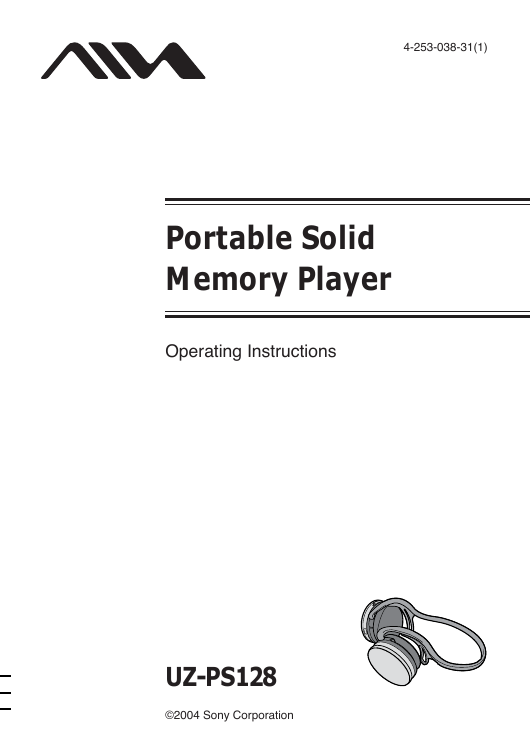
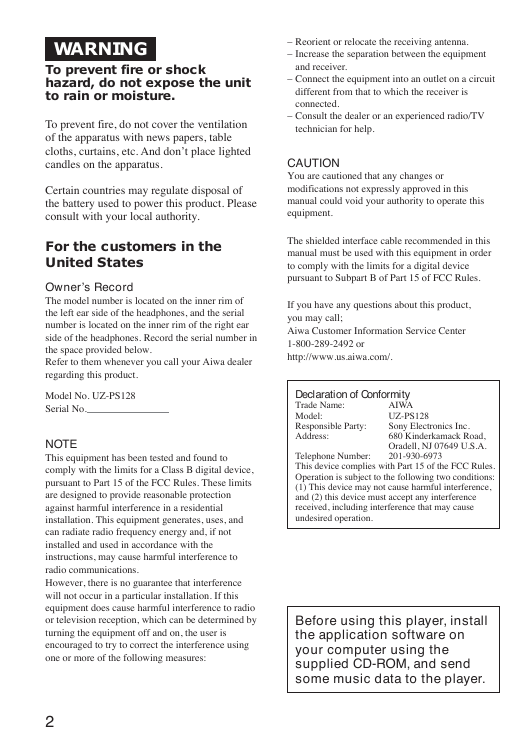
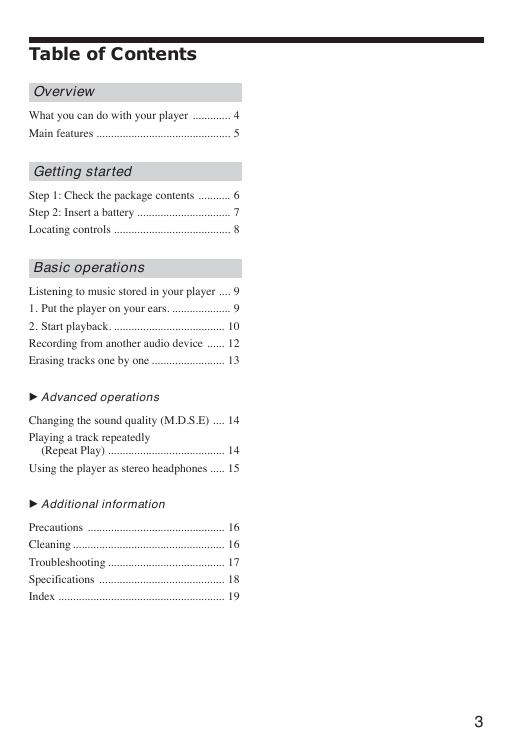
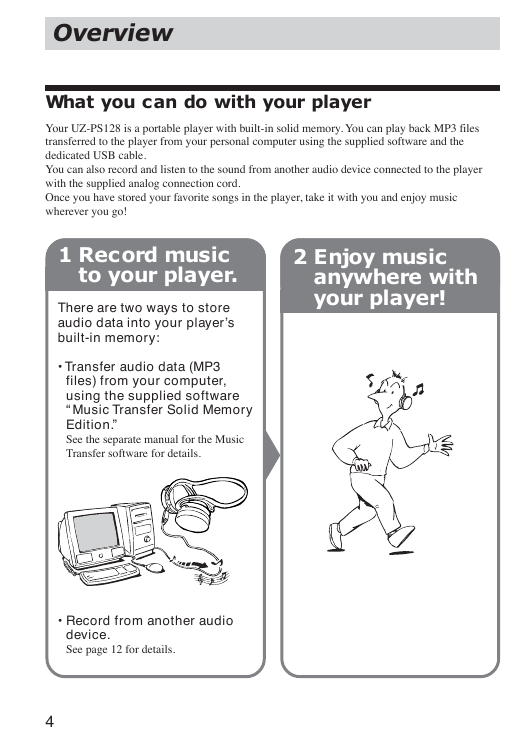

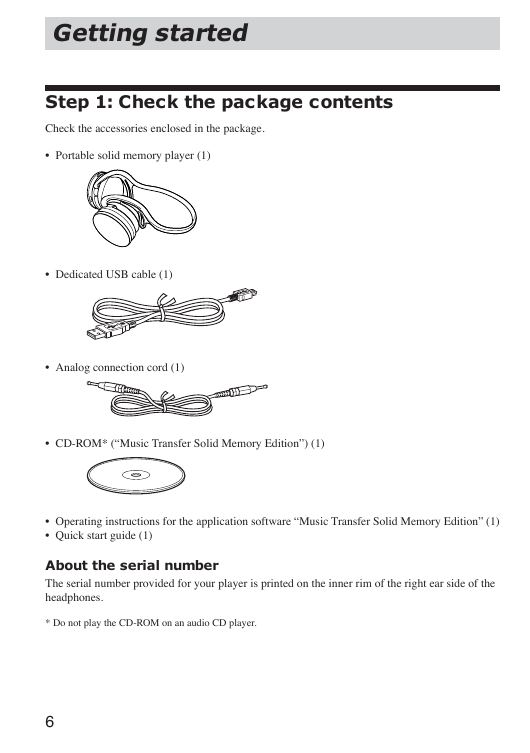
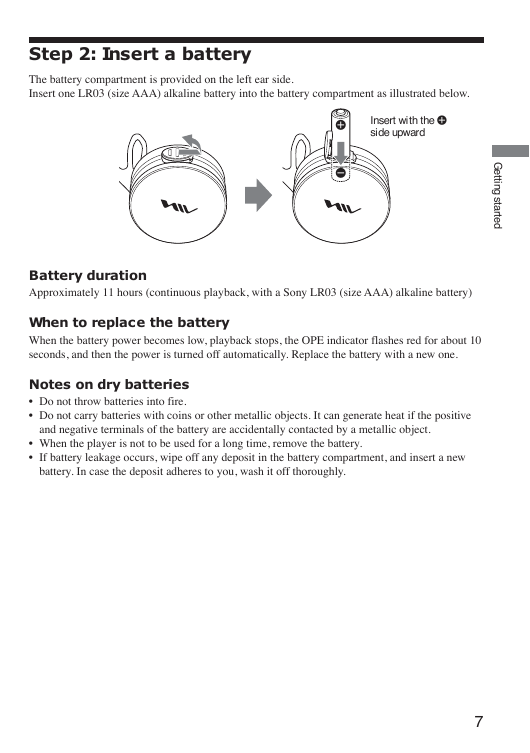
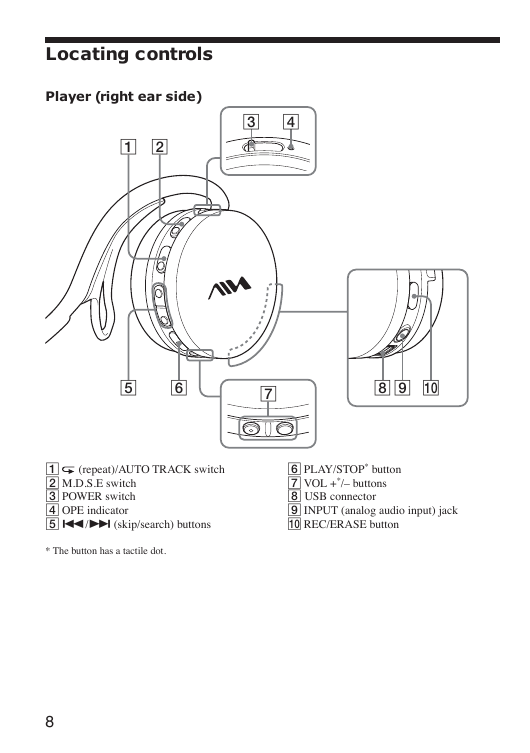








 2023年江西萍乡中考道德与法治真题及答案.doc
2023年江西萍乡中考道德与法治真题及答案.doc 2012年重庆南川中考生物真题及答案.doc
2012年重庆南川中考生物真题及答案.doc 2013年江西师范大学地理学综合及文艺理论基础考研真题.doc
2013年江西师范大学地理学综合及文艺理论基础考研真题.doc 2020年四川甘孜小升初语文真题及答案I卷.doc
2020年四川甘孜小升初语文真题及答案I卷.doc 2020年注册岩土工程师专业基础考试真题及答案.doc
2020年注册岩土工程师专业基础考试真题及答案.doc 2023-2024学年福建省厦门市九年级上学期数学月考试题及答案.doc
2023-2024学年福建省厦门市九年级上学期数学月考试题及答案.doc 2021-2022学年辽宁省沈阳市大东区九年级上学期语文期末试题及答案.doc
2021-2022学年辽宁省沈阳市大东区九年级上学期语文期末试题及答案.doc 2022-2023学年北京东城区初三第一学期物理期末试卷及答案.doc
2022-2023学年北京东城区初三第一学期物理期末试卷及答案.doc 2018上半年江西教师资格初中地理学科知识与教学能力真题及答案.doc
2018上半年江西教师资格初中地理学科知识与教学能力真题及答案.doc 2012年河北国家公务员申论考试真题及答案-省级.doc
2012年河北国家公务员申论考试真题及答案-省级.doc 2020-2021学年江苏省扬州市江都区邵樊片九年级上学期数学第一次质量检测试题及答案.doc
2020-2021学年江苏省扬州市江都区邵樊片九年级上学期数学第一次质量检测试题及答案.doc 2022下半年黑龙江教师资格证中学综合素质真题及答案.doc
2022下半年黑龙江教师资格证中学综合素质真题及答案.doc